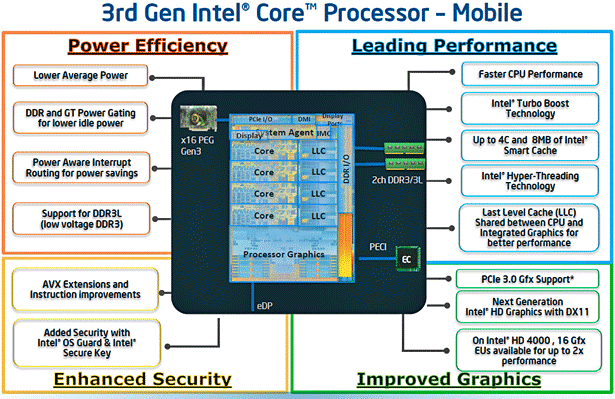Intel Core i7-3720QM Ivy Bridge Mobile Review
Intel Ivy Bridge Mobile Platform Architecture
Intel's 3rd generation Core processor architecture has undergone what can be considered as a major buffing-out. At 22nm and as the first processor to feature Intel Tri-Gate 3D transistor technology, the company was able to pour much more silicon resources and real estate into this processor than ever before; and it shows.




Just looking at the high level architecture and considering the partitioning of silicon area to functional blocks, it's easy to see that Ivy Bridge CPU cores consume only about 1/3rd of the overall die map. This speaks volumes with respect to how Intel has continued to further balance their architecture toward heavier multimedia and graphics-intensive workloads. Note also that Last Level Cache or "LLC" consumes a healthy chunk of real estate as well. Like Intel's Sandy Bridge architecture, this is again a shared memory resource between the CPU and GPU engines and depending on CPU model there is 6 - 8MB of total LLC (or L3) cache.
In terms of architectural enhancements, Intel has beefed up resources for graphics, security processing, AVX Extension (for floating point processing and parallelism), and PCI Express 3.0 Graphics support over its external PCIe links. Intel's integrated HD 4000 graphics core now offers full DX11 support with 16 Execution Units on board now, up from Sandy Bridge's max allocation of 12. The graphics core speed hasn't changed at a max of 1300MHz, though the new engine also supports OpenGL 3.1 rendering now and Intel is claiming a 2X performance boost over Sandy Bridge HD 3000 graphics. Again for additional chip architecture detail be sure to check out our Ivy Bridge deep dive.
In terms of architectural enhancements, Intel has beefed up resources for graphics, security processing, AVX Extension (for floating point processing and parallelism), and PCI Express 3.0 Graphics support over its external PCIe links. Intel's integrated HD 4000 graphics core now offers full DX11 support with 16 Execution Units on board now, up from Sandy Bridge's max allocation of 12. The graphics core speed hasn't changed at a max of 1300MHz, though the new engine also supports OpenGL 3.1 rendering now and Intel is claiming a 2X performance boost over Sandy Bridge HD 3000 graphics. Again for additional chip architecture detail be sure to check out our Ivy Bridge deep dive.

Intel has also made significant upgrades to their PCH (Platform Controller Hub) architecture with the Ivy Bridge mobile platform. The new H77 chipset now offers up to four ports of USB 3.0 connectivity and 10 USB 2.0 ports. Display output for the chipset now supports 3 independent outputs of either DisplayPort, HDMI, or DVI, along with 1 SDVO (Serial Digital Video Out) port. Incidentally, HDMI connectivity is now version 1.4a compliant and 3D capable. Intel is marketing their InTru 3D technology with Ivy Bridge as well, though this technology has been around since the Sandy Bridge architecture.

Along with all of their new processor technology, Intel has been continuing to make inroads with a long list of ISVs in the content creation and video processing/production space. The company's latest iteration of their Quick Sync transcode acceleration technology in Ivy Bridge is actually significantly faster, as you'll see in the pages ahead. We specifically tested CyberLink MediaEspresso and even compared to DirectCompute with discrete AMD-ATI solutions or CUDA on GeForce GPUs, Quick Sync is markedly faster and more efficient.
Before we get too far ahead of ourselves though, let's first take a look at the Asus N56VM notebook that delivered our first Ivy Bridge mobile experience.
Before we get too far ahead of ourselves though, let's first take a look at the Asus N56VM notebook that delivered our first Ivy Bridge mobile experience.






